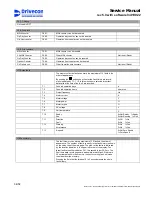
Service Manual
rev 5.0 with software Ind1V022
The purpose of troubleshooting and field repair actions is primarily to determine whether the problems are in
fact caused by inverter or external devices. After that, the next step is to detect the possibly damaged
components inside inverter. If any damage inside inverter is caused by the environment (motor failure, brake
failure, power supply problems etc.) it is very important to repair/change faulty items to prevent further
damage.
-
Check state of digital inputs from parameter V4.7.12
-
Check that load is not over nominal
-
Check that all motor depending parameters are correct
9 TROUBLESHOOTING
Warning! High voltages inside Frequency converter. Wait for at least five minutes after the
supply voltage has been switched off before service actions. The display in the operating
condition (lights on) indicates a dangerous voltage on the DC-bus. When display turns off, the
DC-bus voltage is approximately 100V. Note also that there is always a dangerous voltage in the
braking resistor when the DC-bus is charged.
This chapter describes how to detect inverter failures. The purpose is to find out which components are
damaged and how to replace them to restore proper operation. Advice is also given to find possible external
failures that affect inverter function.
9.1 Field repair actions
The best way to repair a faulty inverter is to replace it with a new one. If the fault can be located, it is also
possible to replace some of the inverter components. Always, if any power component inside the inverter is
damaged, it is also recommended to change the component that controls the damaged component. In the
smallest models, replacing components except for the PC-boards is not recommended due to cost. When
replacing an inverter or a Control unit with a new one, the parameter list of the existing inverter is needed so
that the parameter settings can be copied from the existing inverter.
If parameters have been copied to the keypad before damage, it may be used for uploading the parameters to
the spare part inverter (requires same software versions).
9.2 Typical functional problems
-
Inverter does not start when mains is connected.
-
Check mains voltage between terminal L1, L2 and L3
-
Led “Ready” is on and led “Fault” is off, but motor does not run.
-
Check control mode selection
-
Check voltage at run command terminal X1:8 and X1:9
-
Motor runs poorly
-
Check that all cables are connected correct and the junctions are reliable
-
Check voltage at slow down terminals X1:39 and X:40
-
Check state of digital inputs from parameter V4.7.13
-
Check that motor’s brake opens
-
Check that minimum speed parameters do not have too small values
-
Check u/f-curve tuning
-
If the main girder is new, it might be necessary to drive trolley several times with no load from end to end, before beginning of u/f-curve
tuning
-
Some parameters are not accessible or changing is not possible
-
Check password
-
Check that parameter value is inside the limits
-
Parameter can not be changed in RUN state
-
Parameter change must be confirmed with “Enter” button
46/58
Drivecon Inc. reserves the right to alter or amend the above information without notice.
Summary of Contents for D2L
Page 59: ......














































